
Rocky Outcrop, Kenya
From a rocky outcrop in Kenya’s Masai Mara, a male African Lion surveys his territory, perhaps searching for his pride or on the lookout for trespassing males who might challenge him for possession of his kingdom.

Sound Asleep
Like all cats, Lions spend a lot of their time sleeping, perhaps as much as twenty hours a day. Patiently waiting on a somnolent Lion will eventually be rewarded, but sadly, many tourists are too impatient and drive off to find more interesting sights.

Nocturnal Creatures
Like all cats, Lions are nocturnal, and under the cover of darkness the cats hunt, play, and patrol their territory. In the course of a single night, Lions may travel a dozen miles or more, seeking game, marking territory, or driving off intruders.

Lions are nocturnal, and under the cover of darkness the cats hunt, play, and patrol their territory.
Mane Event
Only male Lions have manes, and studies have shown that Lionesses prefer males with the darkest, thickest manes, as these are an indication of fitness and strength. Males reach their prime by age five, although a big black-maned lion like this one may be seven or eight years old.

Adaptation
In semi-desert habitats, the mane of a male Lion is sparse. In grasslands, a conspicuous, thick mane serves as a visual signal, alerting potential rivals of their presence, health, and vigor. In brush country, a conspicuous mane would have little value.

In the Dawn’s Early Light
At dawn, a male African Lion patrols his territory, roaring periodically to announce his presence. Lions also use scent to mark their territory, rubbing their chins on brush and spraying urine to warn off rivals.

Safari guides say this roar appears to say, “Whose land? Whose land? Whose land? Mine! Mine! Mine!”
Sounding Off
A lion’s roar can be heard for miles. Safari guides say this roar appears to say, “Whose land? Whose land? Whose land? Mine! Mine! Mine!,” and indeed the cadence of this roar mimics this phrase nicely.
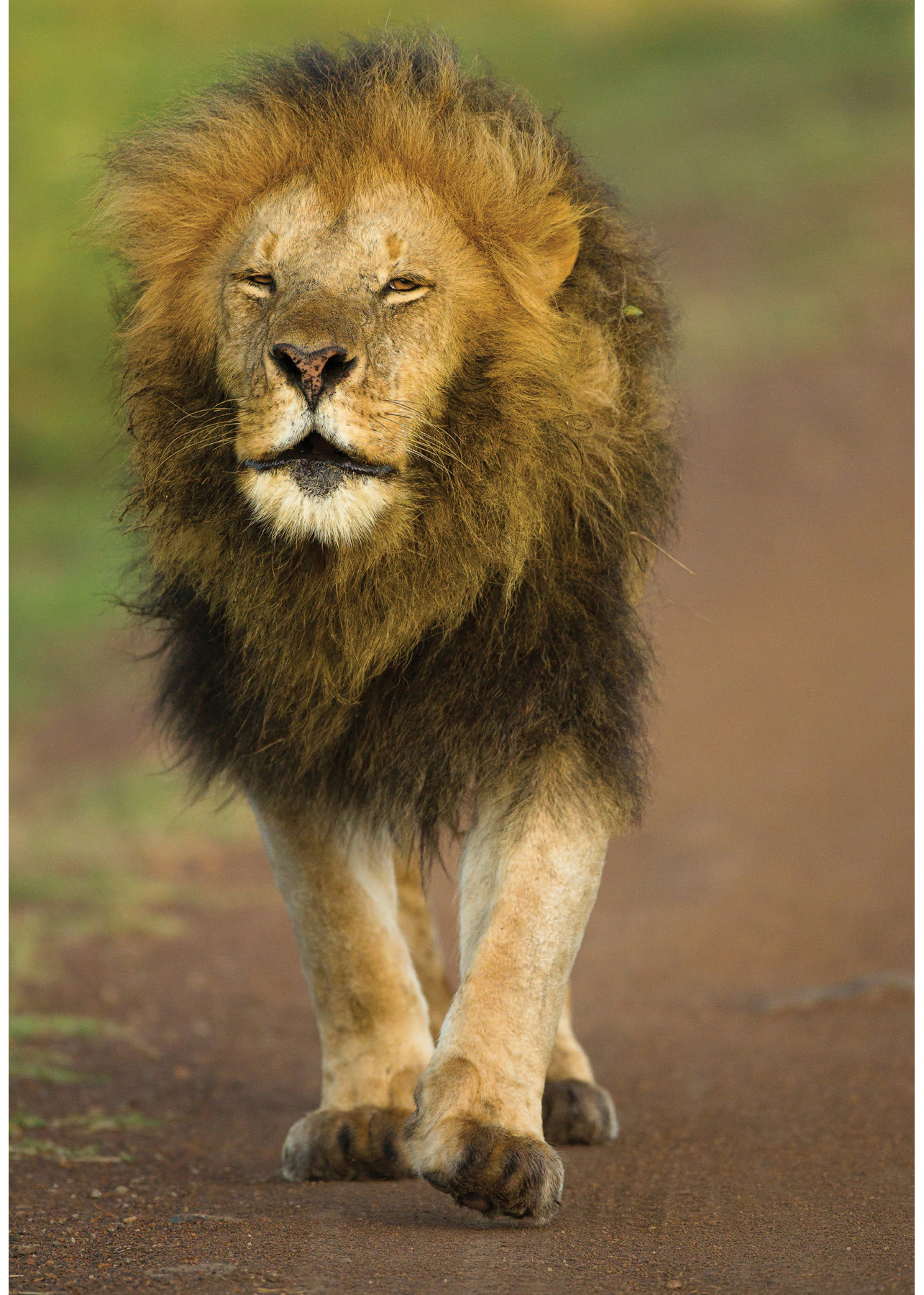
A Mighty Roar
Even a full-bellied Lion that is too lazy to stand can roar and will do so to answer that of another, sometimes prompting the entire pride to roar in a resounding chorus. Should you be fortunate enough to be in front of, and close to, a roaring Lion, you can actually feel the vibrations in the air.

Short-Lived Glory
While one male Lion may possess a pride, his tenure may last for less than one year. Two Lions hold on to their pride on average for about two years, and three Lions an average of around three years, but coalitions of four or more male Lions can control a pride for several years.
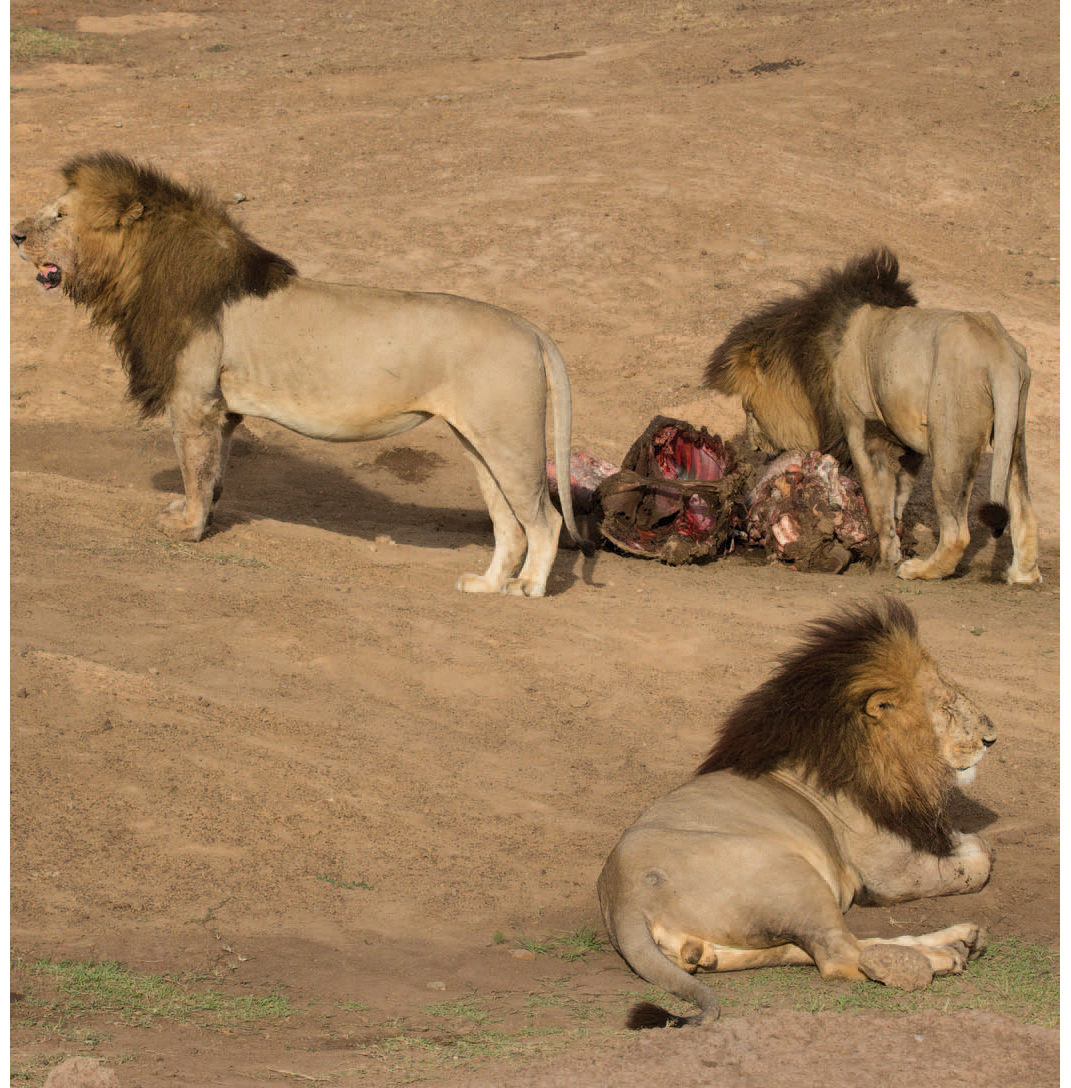
I Stand Alone
Lionesses often hunt alone, especially when the large herds of Gnus and Zebras have moved on. At various times, but especially at night, Lions may keep in contact with other pride members by roaring, although days may go by before members of a pride reunite.

Camouflage
In tall grass, a Lioness hunkered down low can be nearly invisible, especially when the grasses dry and glaze a golden brown. Even in fresh green grass, a Lion is well camouflaged. Prey animals, like Gnus and Zebras, are colorblind, making a tawny cat in green grass virtually invisible as the two-color tonalities are similar.
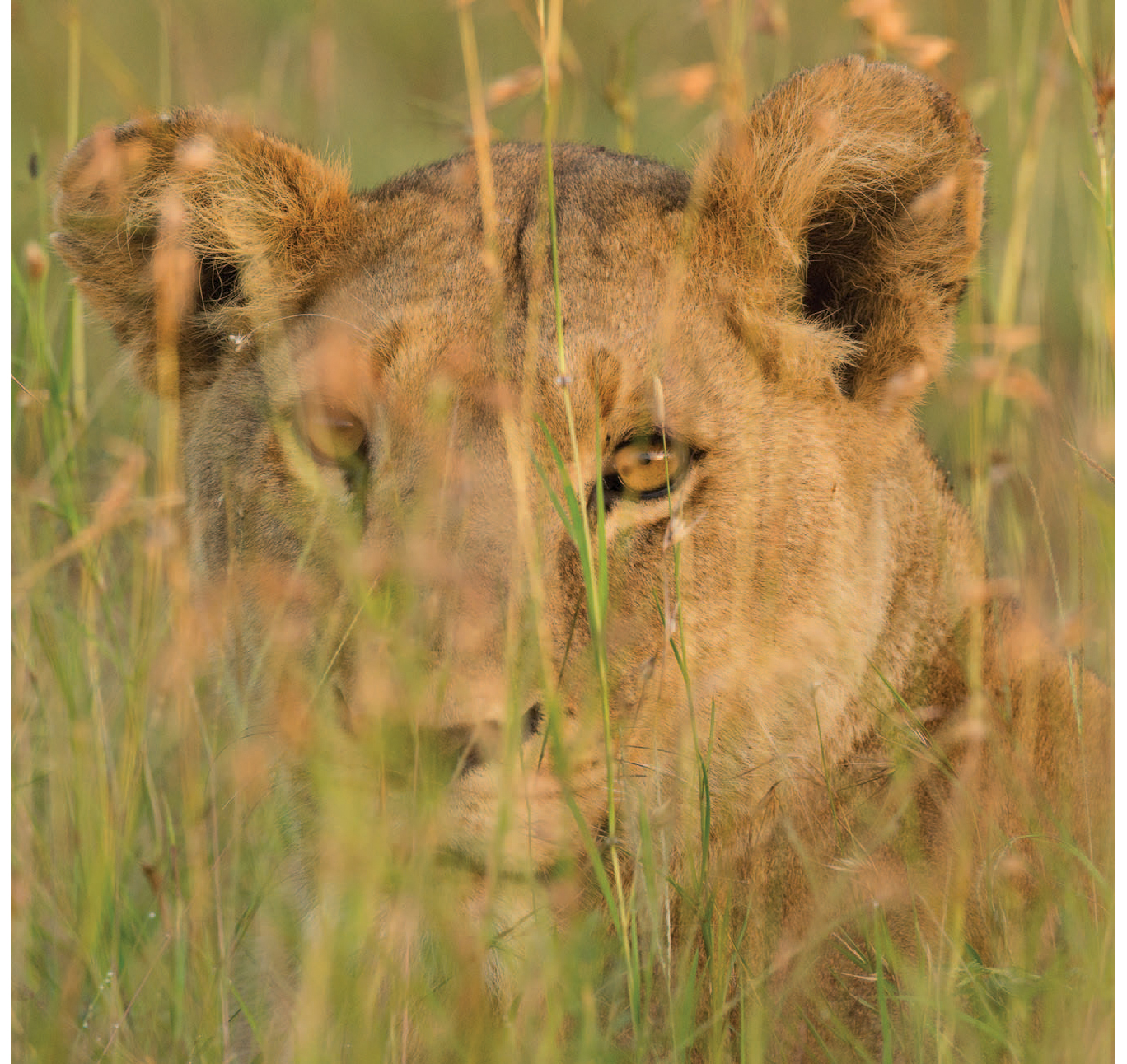
A Warthog Escapes
Although this Lioness waited until the Warthog passed only a few yards from where she lay in wait, the hunt was unsuccessful, as the Warthog sprinted away to safety.

Remains
Two Lionesses scramble to take possession of the remains of a Warthog they captured only a few minutes earlier, and in that time the carcass was torn in half. The violence and strength of several Lions fighting over their prey was shocking to see, giving us insight into the cats’ incredible power.
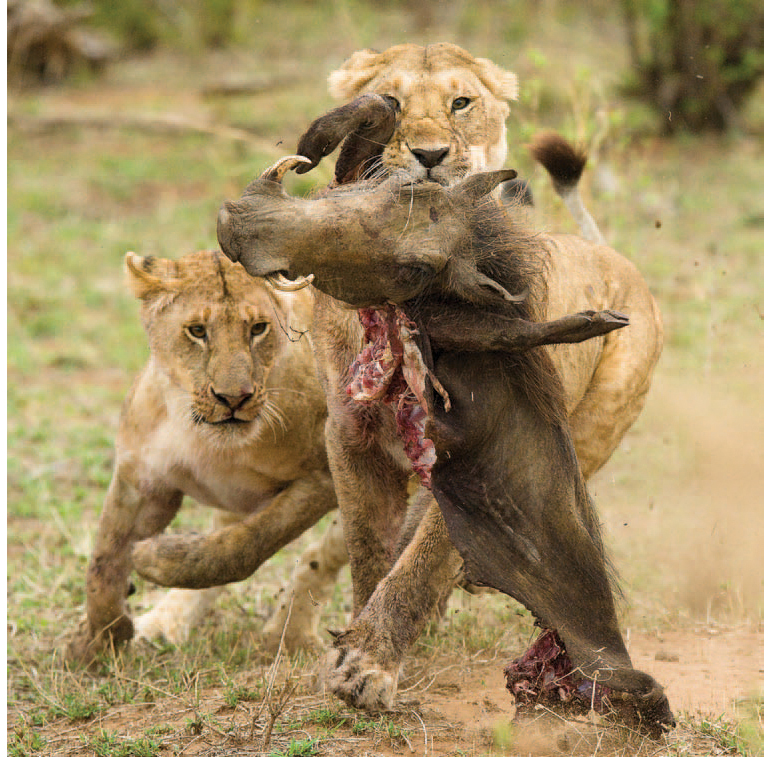
Teamwork
When working together, several Lions can overcome and take down animals as large as a Hippopotamus or a sub-adult Elephant. A single Lion will prey upon baby Hippos and Elephants, although the mothers of either may deter any attempt at predation.

Zebra Fights Back
Hunts can be dangerous, and a Lioness may be kicked by a Zebra, resulting in broken bones or teeth. Once, we found a starving Lioness who had her entire lower jaw removed by the well-placed kick of a fleeing Zebra.

In Pursuit
A Lioness watches as her half-grown cub pursues an orphaned Gnu calf that trotted right into the pride. Lionesses train their cubs to hunt by capturing small prey that they’ll release for their cubs to chase and tackle.
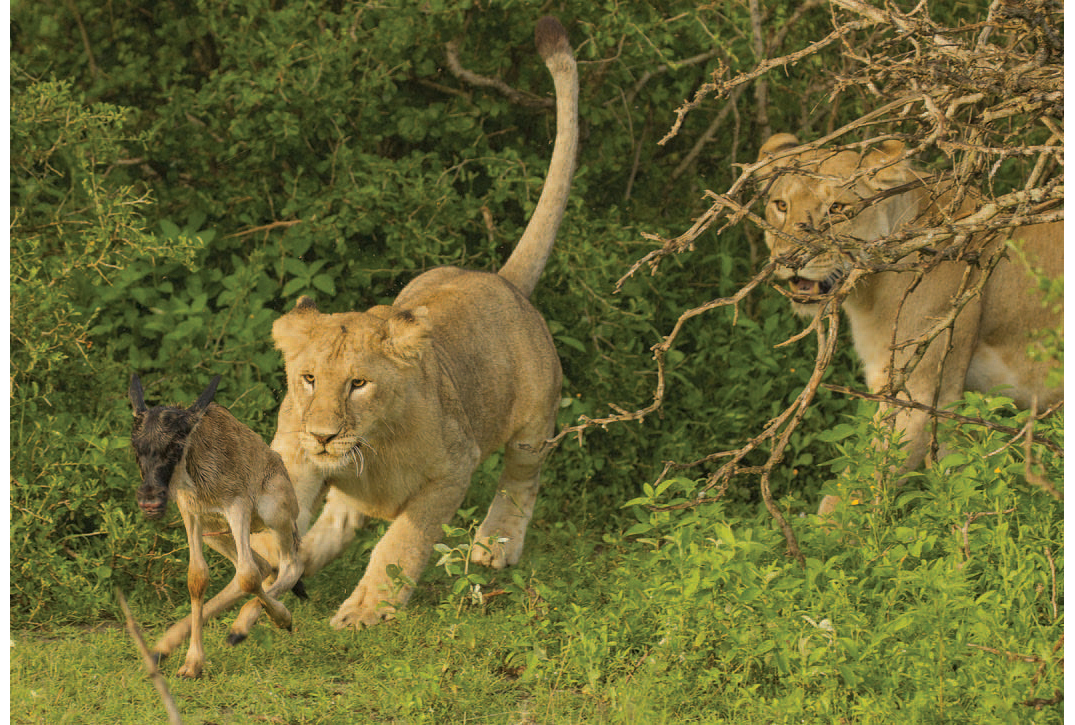
Gnu Story
One of the funniest hunts I’ve ever photographed occurred when a Gnu, chased by a Lioness, suddenly spun and faced his attacker. The Lioness, programmed to chase prey, stopped and seemed confused. Apparently, so was the Gnu, as it soon turned and fled. The Lioness resumed the chase, but the Gnu did another face-off. This happened several times until the Lioness grew too tired to continue chasing the very brave Gnu.

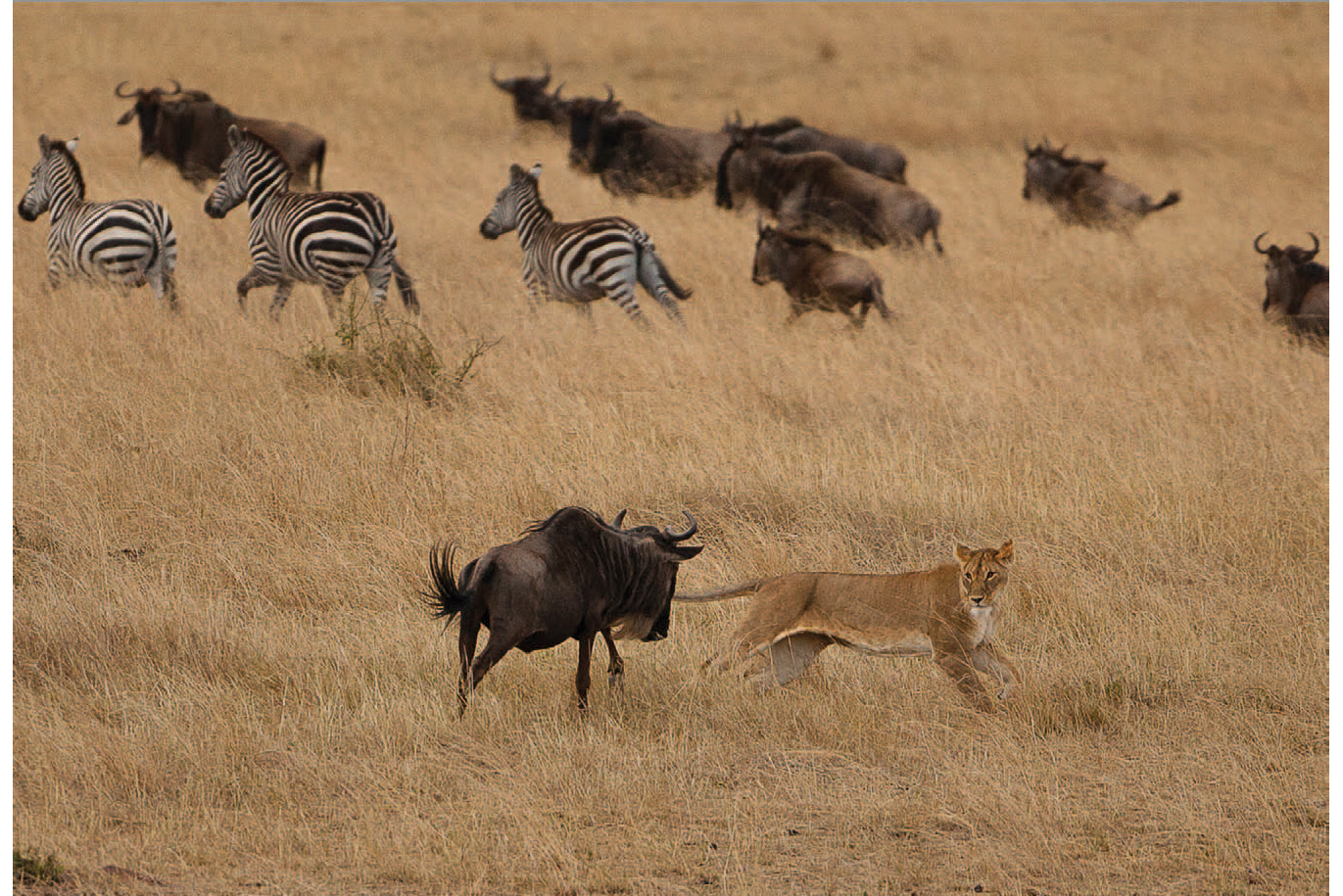
A Distinct Disadvantage
A single Lioness is no match for an African Buffalo, nor is an entire pride when a Buffalo herd is present. These two Lionesses made no move toward the Buffalo, although their potential prey had other ideas.
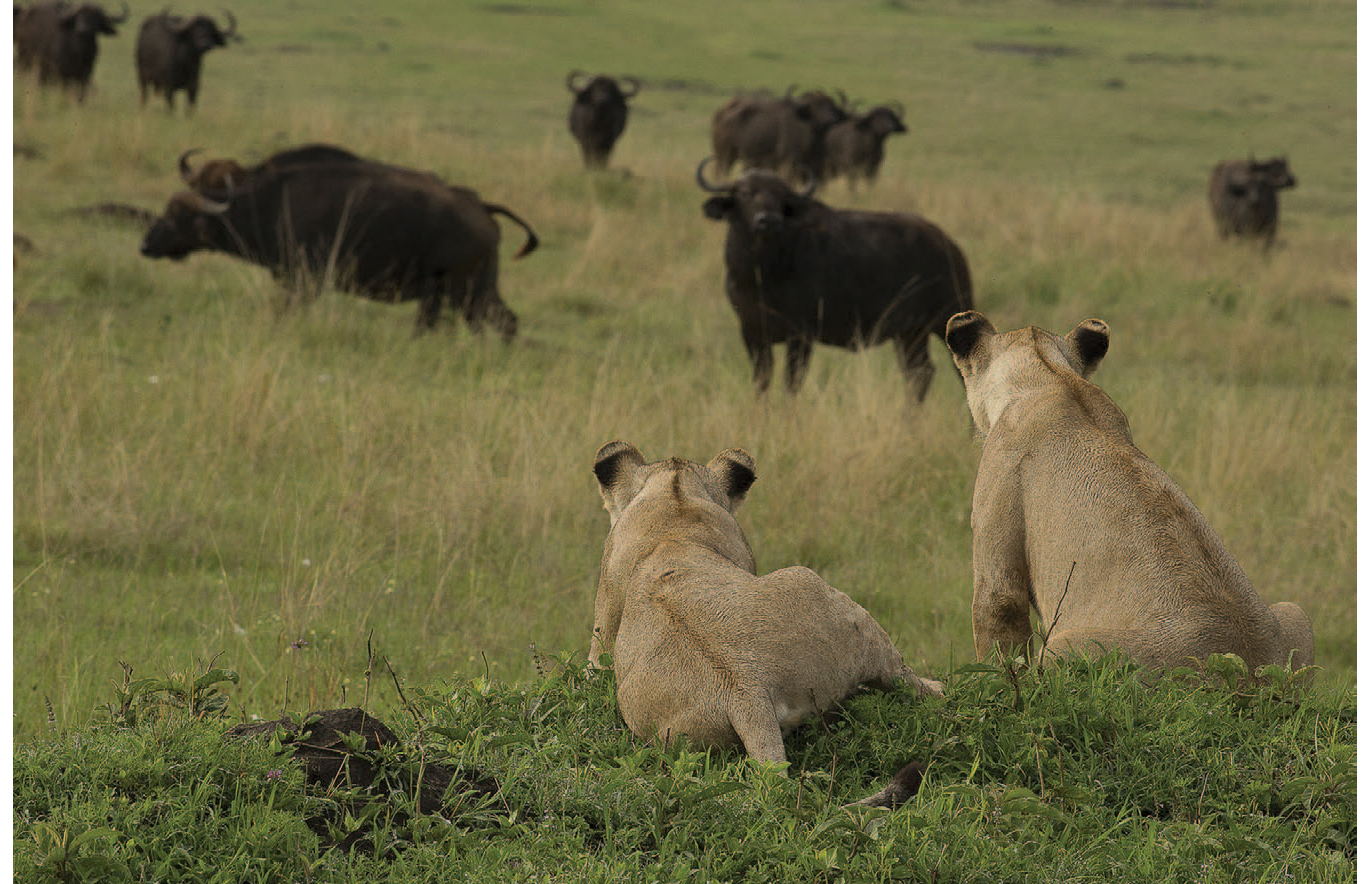
The Lioness, programmed to chase prey, stopped and seemed confused.
Seeking Safety
A few minutes later, the Buffalo herd turned and approached the Lionesses, who retreated with their cubs. Several of the aggressive bulls charged the pride, scattering the Lions as they ran to the safety of a distant rock pile. The Buffalo would have killed any Lion cubs they caught.


A Group Effort
Seven male Lions, all members of a large pride, piled onto a lone bull Buffalo that had wandered too close to the sleeping cats. Sometimes these struggles can last for hours, but the combined weight and strength of the seven male Lions ended this battle in only fifteen minutes.

Vulnerable
At one point, a male Lion grabbed the snout of the bull, attempting to twist its neck and wrestle it to the ground. Head-to-head, a Lion is very vulnerable should the bull shake itself free, as the sharp horns of the Buffalo would skewer its attacker.

A Worthy Competitor
Although known as scavengers, Spotted Hyenas make many of their own kills, which are later stolen by Lions. A single Lion can drive off a pair of Hyenas, but often not without a fight.

Retribution
The tables turned after three Lionesses stole a Hyena’s kill. The Hyenas whooped in reinforcements. In minutes, two dozen Hyenas appeared, chasing the Lionesses and biting any cat they could isolate. The battle ended when a male Lion arrived and drove off the Hyenas, who show far more fear or respect for the larger males.
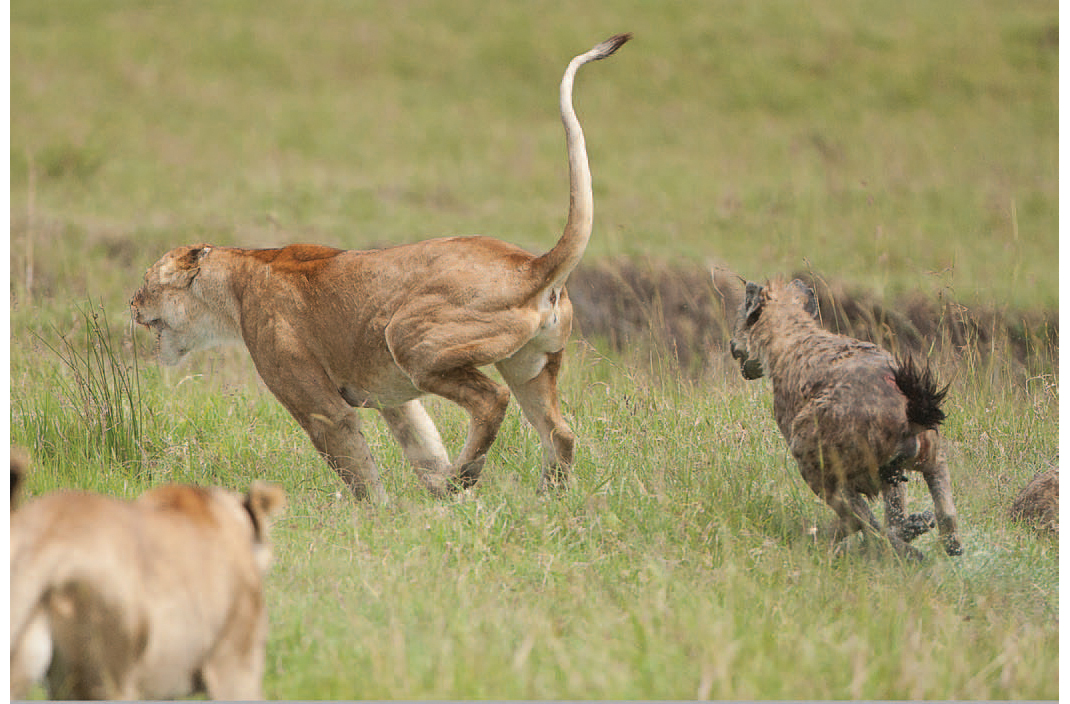
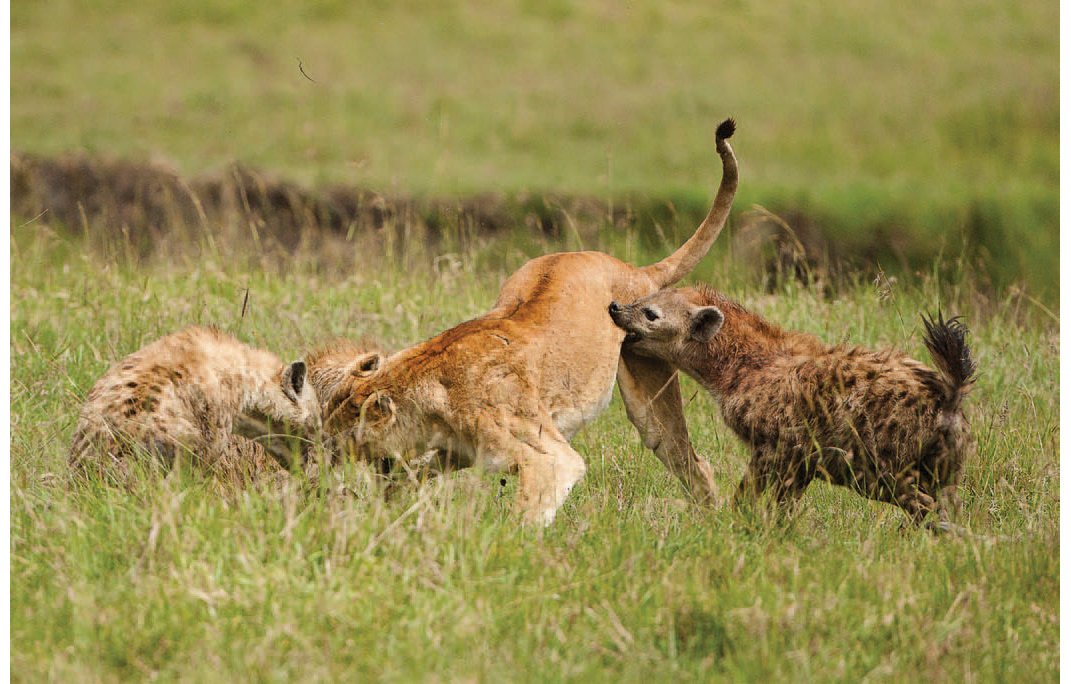
All in the Family
Lions are the only cat who live in large family groups, known as prides. Pride territories are inherited through the females, with male Lions keeping possession of the pride only until they are replaced by stronger males, who drive off or kill the previous “kings.”

Newcomers
New males are not immediately accepted by the Lionesses, as the newcomers will kill all of the young cubs, bringing females back into heat. To save their young, Lionesses will fight and, if the males are not tenacious, will drive the new males away.

Not Welcome
Lionesses, should they leave their own pride’s territory, are not accepted by the females of another pride and will be killed. These females hope to bite the spine and paralyze or cripple the intruder.

Out of Harm’s Way
Young cubs will be carried by their mothers, sometimes for long distances. This Lioness was taking her cubs to a new den, fearful that the new males in the area would find and kill her cubs. Chances are, the males eventually did just that.

Paternity
While male Lions will kill any young cubs they find when they take over a pride, they are tolerant and protective of their own cubs. Nonetheless, the first minutes after a Lioness introduces her cubs to the pride are tense, as cubs could be killed by mistake by their own father.

Orphan
We think this tiny cub was the orphan of a Lioness poisoned by herdsmen. Although carried to the pride by another Lioness, none of the females would nurse the young cub, despite the face that sisters and aunts normally nurse cubs that are not their own.

A Milestone
After about ten days, a cub’s eyes open, although the cubs are still nearly blind and very awkward. They’ll remain at a den site for another six weeks before the Lioness takes them to join the pride.

Watchful
A Lioness waits for one of her cubs as she begins the dangerous journey cross-country to join up with her pride. Cubs that can’t keep up, perhaps by being weak or injured, may be abandoned during the trek.

Self-Protection
A Lioness will be fiercely protective of her cubs, but in lean times a Lioness may eat everything she catches and let her cubs starve. While this seems cruel, a Lioness will have many opportunities during her lifetime to successfully raise cubs.


Sharing the Kill
Because a male’s ownership of a pride is limited, a Lion may have only one chance to pass on his genes and have his cubs survive to maturity. Consequently, a male Lion will often share a kill with his cubs, but repel any Lionesses attempting to snatch a meal.
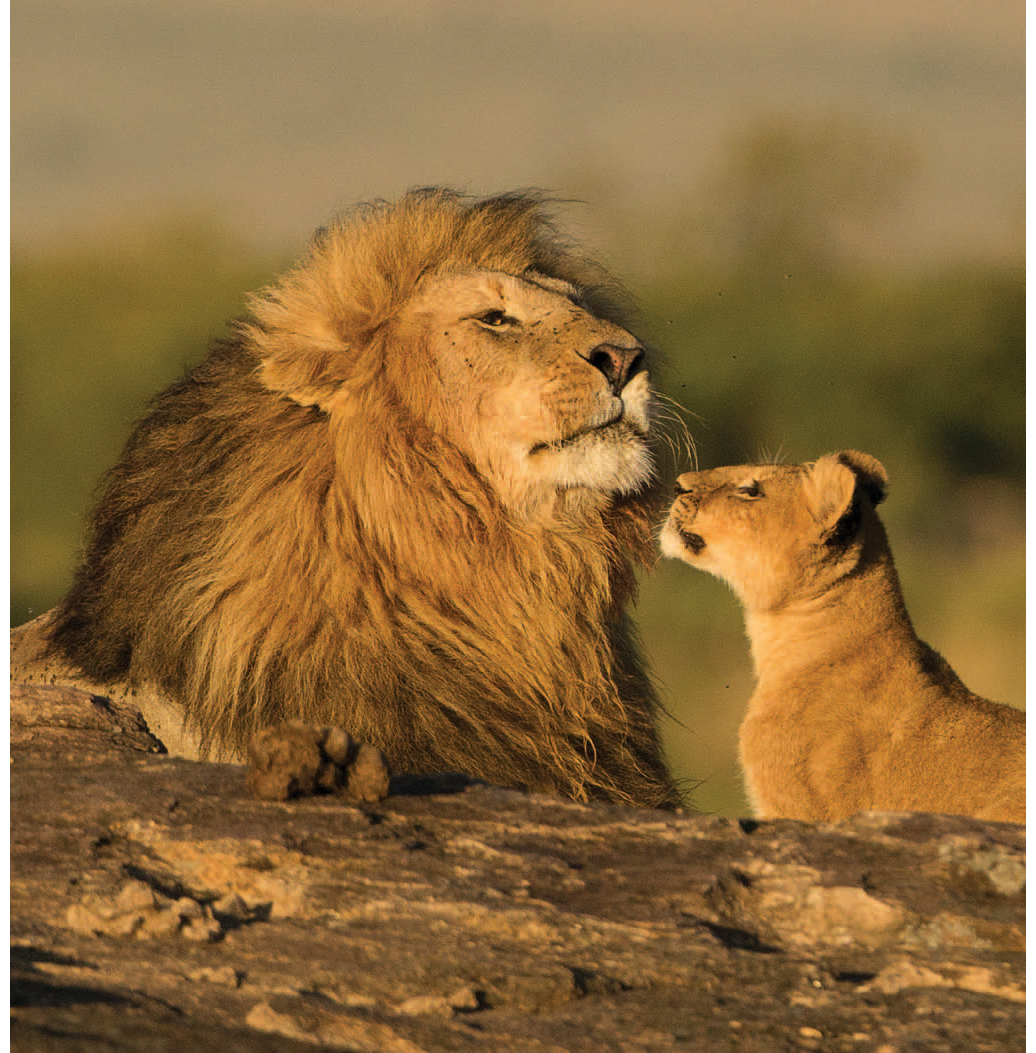
Caption This!
The camera captures a moment that begs for a caption. Is the cub complaining? Was there a bad joke? Bad breath? Or just the end of a pair of yawns?

Climbing
Lions can climb trees and, if there are sturdy branches, even male Lions may climb high into a tree to sleep or to escape pesky biting flies. Like most cats, Lions cannot rotate their ankles as a squirrel (or a Clouded Leopard) can, and to descend, Lions either must jump or slide down a tree trunk backward.


Playtime
Cubs love to play, and often practice their later hunting skills, by biting the neck of their opponent. Play activity, regardless of the Lions’ ages, is greatest a day or two after they have eaten, when hungers are sated and the cats have plenty of energy.
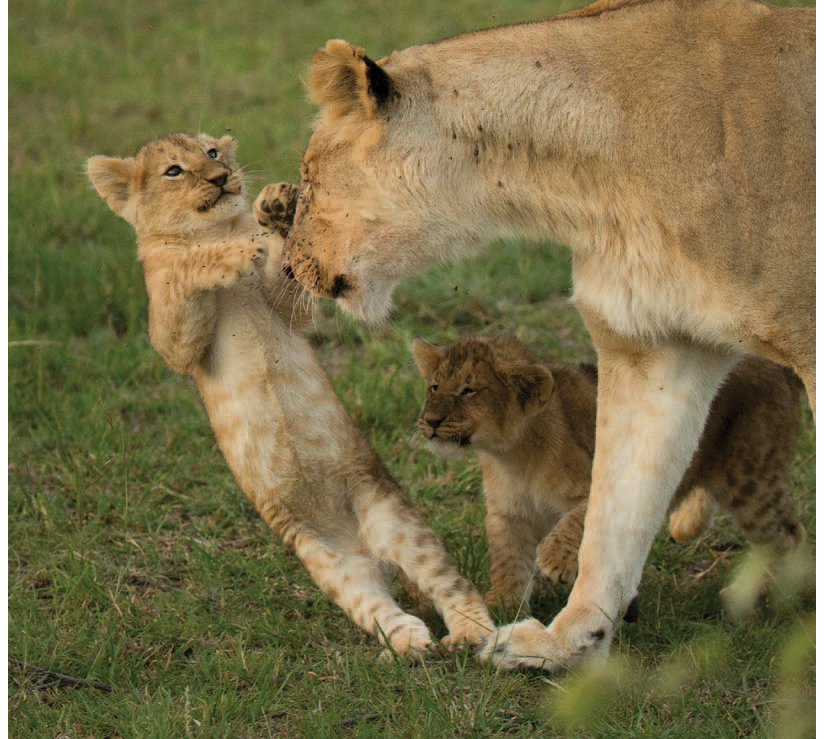
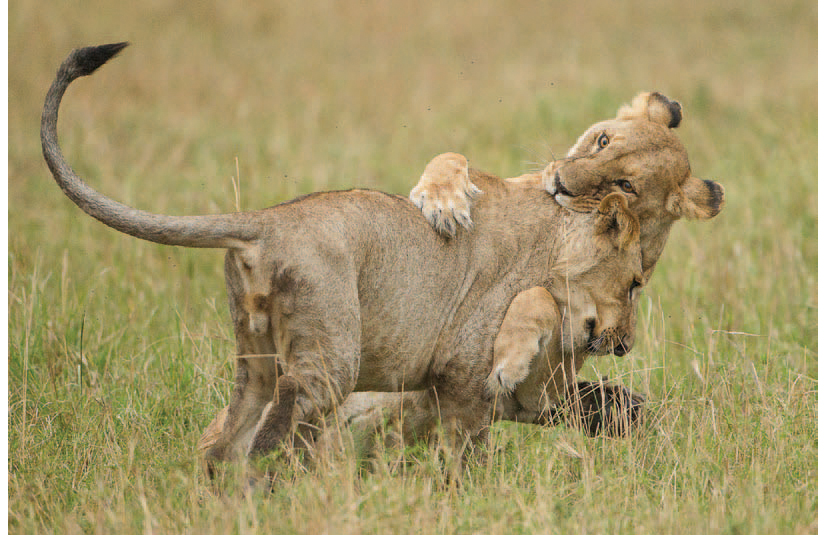
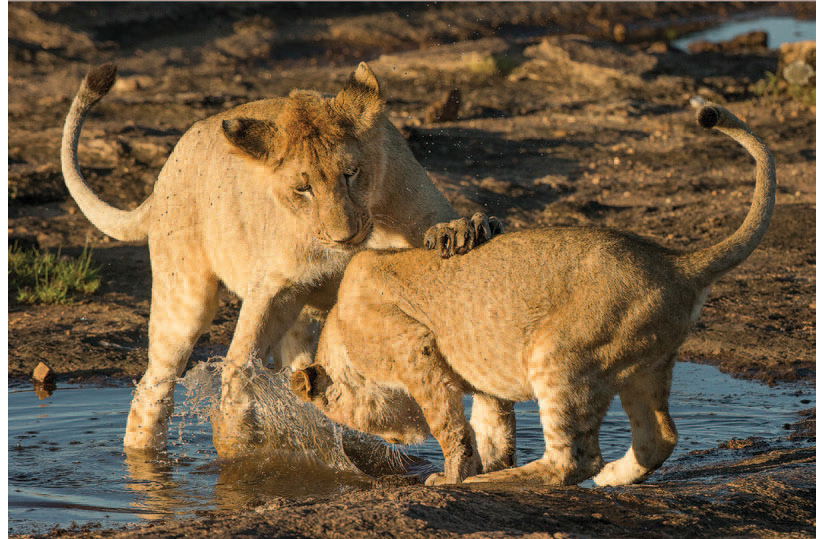
Adults Play, Too
Even adult Lions will play. At first glance, the cats might appear to be fighting, but note that their claws are sheathed and their muzzles mask their canine fangs. In a real fight, both fangs and claws would be exposed—and used!

Charge!
This charging Lioness’s aggression was directed at her sister, whom she mauled right in front of me. Although I thought the cats were involved in a serious fight, when I reviewed my images later, I found that neither Lioness had her claws exposed.
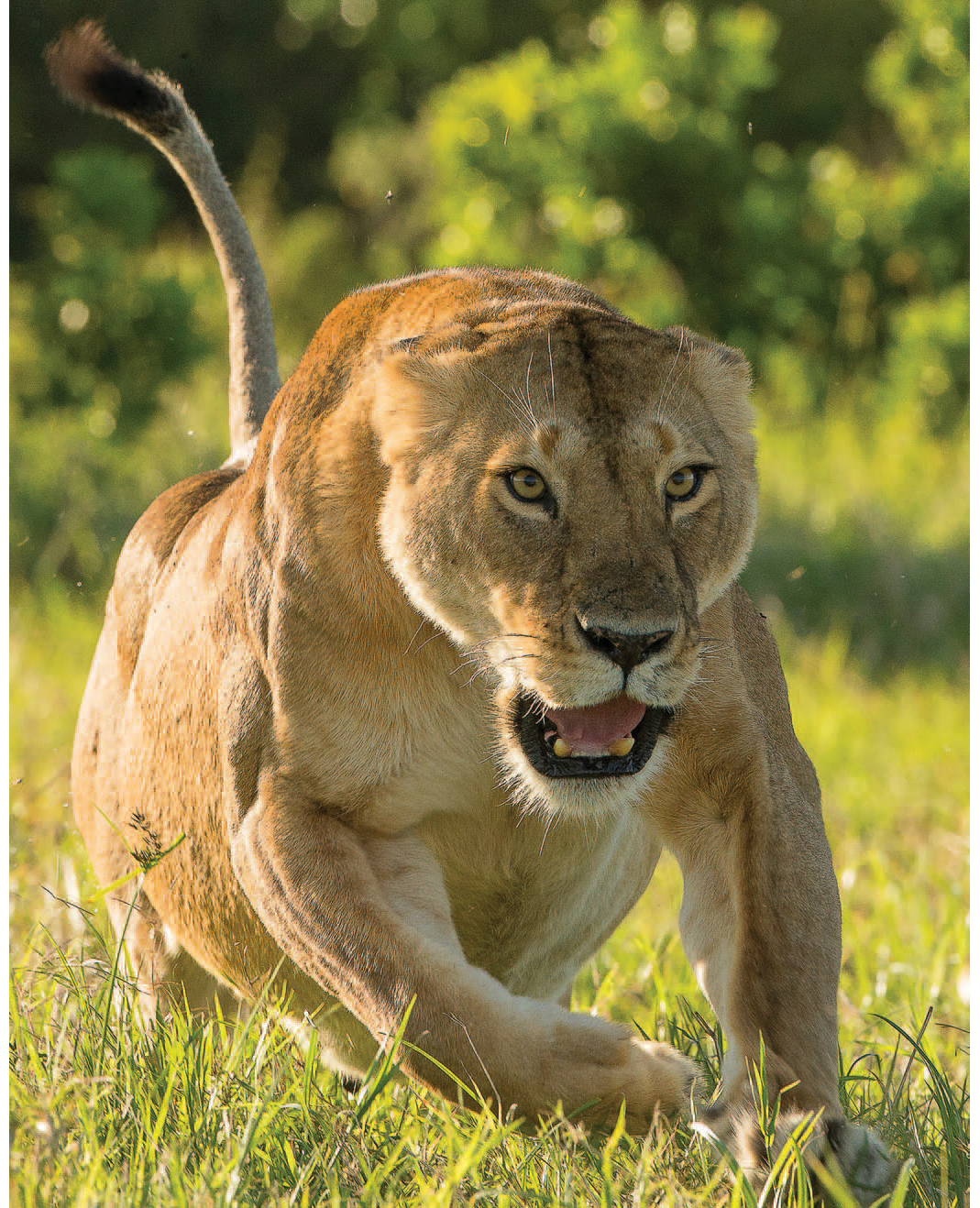
Danger
All Big Cats are potentially dangerous, but in nearly thirty years, I’ve felt really threatened only once. A Lioness that completely ignored three other vehicles was fixated on mine, and every time we approached, the Lioness threatened to charge. Wisely, after recognizing this, we drove off.

On the Rise
At one time, Lions roamed across Africa, the Middle East, and western Asia into northern India. The Asian Lion is all but gone and is now restricted to the Gir Forest sanctuary and its surroundings in western India. Fortunately, this population, unlike those in most of Africa, is thriving and increasing in numbers.
